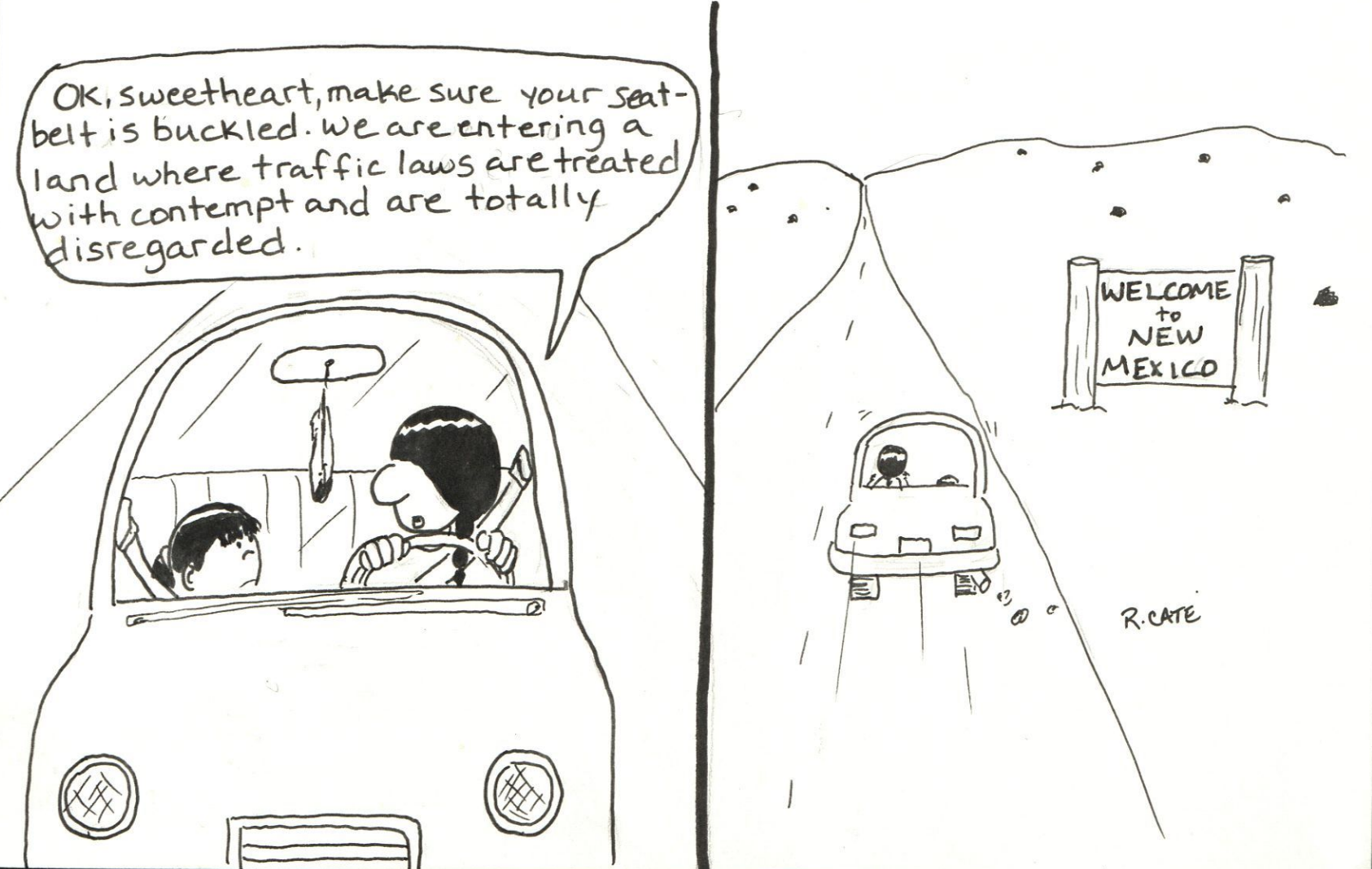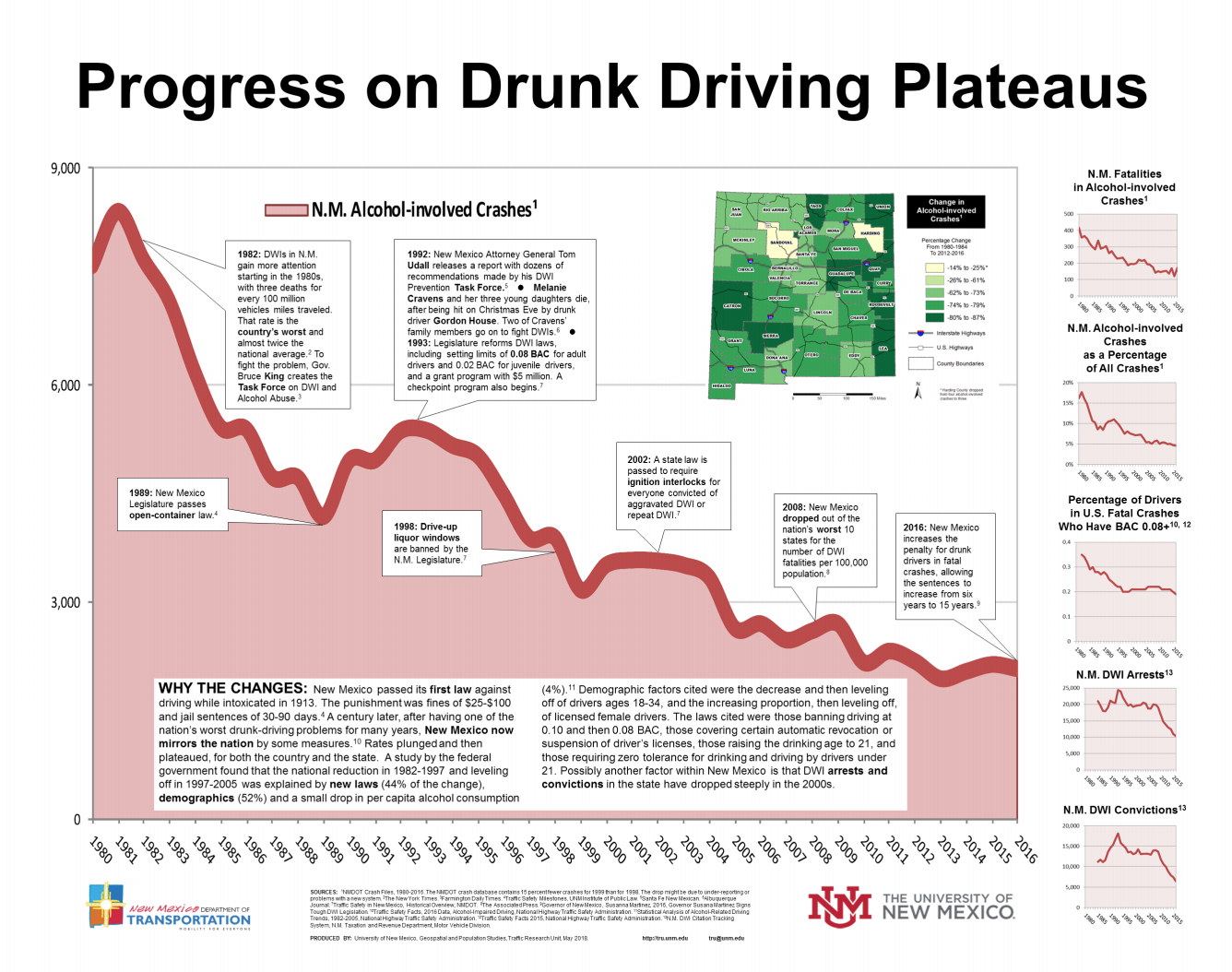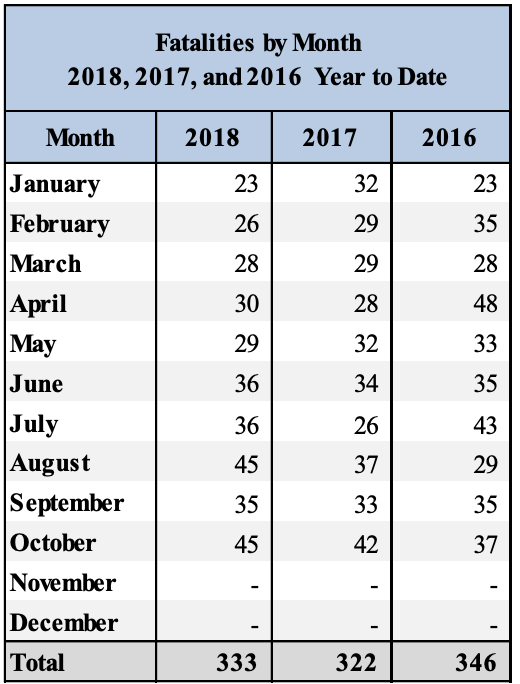“New Mexico has the worst drivers because the average cop doesn’t enforce the law.”
“I think New Mexicans are the worst drivers because we get distracted easily…”
“We are the worst drivers…in NM because we have the most crashes, the most DWI’s and no one really pays attention in our state.”
These are a few of the many hand-written impressions of New Mexico drivers from students of Coach Al’s Driving School in Albuquerque. The negative impressions are not unfounded.
The data show New Mexico making long-range improvements in alcohol-related traffic crashes but inconsistent improvements in traffic accidents overall — as the number of traffic fatalities rises and falls over the years.
Experts say a lot has been done but more improvements are needed when it comes to traffic safety in the state.

ALCOHOL INVOLVED INCIDENTS
The University of New Mexico’s Geospatial and Population Studies, Traffic Research Unit saw a significant reduction in alcohol-involved crashes in the state, from the peak in 1981 to the latest data in 2016.
According to the study, New Mexico’s alcohol related deaths garnered national attention in the 1980s, “with three deaths for every 100 million vehicle miles traveled.” This was the worst in the country and almost twice the national average.
In 2008, the state was no longer was in the top ten states for DWI fatalities. By 2016, there were fewer than 2,000 crashes, compared to almost 8,500 crashes in 1981.
Government response to highway safety problems played a big role in improving the numbers, according to resarch by the Traffic Research Unit.
Data from the Traffic Research Unit shows legislation correlates with a decrease in drunk driving fatalities.
- 1989, the state legislature passed the open-carry law which banned open alcohol in vehicles.
- 1998, Drive up liquor windows were banned.
- 2002, New Mexico was the first state to require ignition interlocks for everyone convicted of aggravated DWI or repeat DWI.
- 2016, New Mexico increases the penalty for drunk drivers in fatal crashes increasing sentencing from six years to 15 years.
“We have a very comprehensive ignition interlock law,” said New Mexico State Police Officer Dusty Francisco.
The ignition interlock device, which can temporarily lock a car from the blood-alcohol content through a breathalyzer. New Mexico was the first state in the country to implement the device.
Dolly Otero, the lead victims specialist for Mothers Against Drunk Driving (MADD), recognizes the reduction in drunk driving, but said there is more that can be done.
“I wish there was stricter laws for DUI [offenses],” Otero said.

Otero also wants get to the root of the behavior of DUI reoffenders.
“People often drink to medicate, and they continuously drink and drive,” Otero said. “I want to see more of a treatment program, a recovery court for re offenders.”
Otero supports the implementation of Driving Alcohol Detection Systems for Safety (DADSS). A technology in a vehicle that can automatically detect whether a person’s blood alcohol concentration is at or above .08 percent.
New Mexico Department of Transportation (DOT) Traffic Safety Director Franklin Garcia said that the DOT has partnered with MADD to work on the adjudication process with DWI cases.
“We entered an agreement with MADD, for court monitoring to see is if a DWI case to see if the penalties.”
New Mexico is one of 13 states that has a MADD courtroom monitoring program.

According to the MADD Court Monitoring 2017 Report, of the 365 cases entered into the database, New Mexico has a 38 percent rate of drunk driving convictions in 2017. These drunk driving cases included 139 guilty convictions, 157 dismissed cases, and the rest include deferred prosecution, amended and not guilty charges.
According to data from the Traffic Research Unit, so far in 2018, New Mexico has had 333 fatalities on the road, 97 were alcohol involved. This means 2018 will is already more deadly than 2017 and may be as bad as 2016.
New Mexico DOT has different public safety campaigns to reduce fatalities in the state. They include traffic safety clinics, and a ENDWI campaign with billboards, radio, television ads and a virtual reality video.
“Driving education is still mandated in this state. It is still mandatory. So teens that are getting their [learner’s] permit and driver’s license,” Garcia said. “With that driver’s education six hours of DWI training is required,” Garcia said.
Al Guadagnoli, known as Coach Al, owner of Coach Al’s Driving School in Albuquerque, said that the DWI portion of the training could be improved.
“I think it needs to be focused more,” Coach Al said. “Some of those DWI questions don’t pop up, the questions should be mandated like the regular questions on the test.”
MORE DISTRACTED DRIVERS
For almost 20 years of providing driver education instruction, Coach Al has noticed that distracted driving is a trend among beginner drivers.
“Texting is a big thing. I see students try to pull out their phones, while they drive, when they hear it buzz,” Coach Al said.
New Mexico State Police Officer Dusty Francisco believes that the dangers of distracted driving, like texting and driving and talking on cell phones, is real and the solution is education.
“That’s why state police are out there enforcing traffic, being more visible and writing citations,” Francisco said.
Additionally, state police have put out ads and commercials to educate on the dangers of distracted driving.
NEW PERILS ON RURAL ROADS
According to the National Highway Traffic Safety Administration there were 37,461 fatalities in the U.S. in 2016, an increase of 5.6% from 2015.
Garcia and Francisco both point to the southern rural parts of the state as a hotspot for fatalities and accidents. In particular the San Juan county and Carlsbad areas.
“You have the oil fields down there so traffic is a little bit more dense,” Francisco said.
“We’re seeing a lot more impact down south. There’s a lot more heavy traffic, there’s a lot more oil production and we’re seeing drivers in those two lane roads have a lot more interaction with those large trucks,” Garcia said.
The Traffic Research Unit reported that there were 1,971 crashes in the San Juan County area in 2016 where the San Juan oil basin is.
“We like to take the data and see what we can do,” Garcia said.
The DOT has worked with educating drivers in southeast areas and worked with law enforcement to enforce safety corridors and command higher penalty fines in certain areas.
Albuquerque, due its population size, is going to be one of the other hotspots in the state, according to Garcia.
“The majority of crashes that are going to include fatalities or serious injuries are going to be in rural areas. That’s due to the speed and the situation and someone is in a crash where emergency services are not readily available. Urban [areas] will have more low impact crashes” Garcia said.
Coach Al tells his students that a “planned day is a safe day.”
“If you learn how to be a defensive driver, you won’t wreck,” Coach Al said.
You can follow Sol Traverso on Twitter @SolTraversoinc.